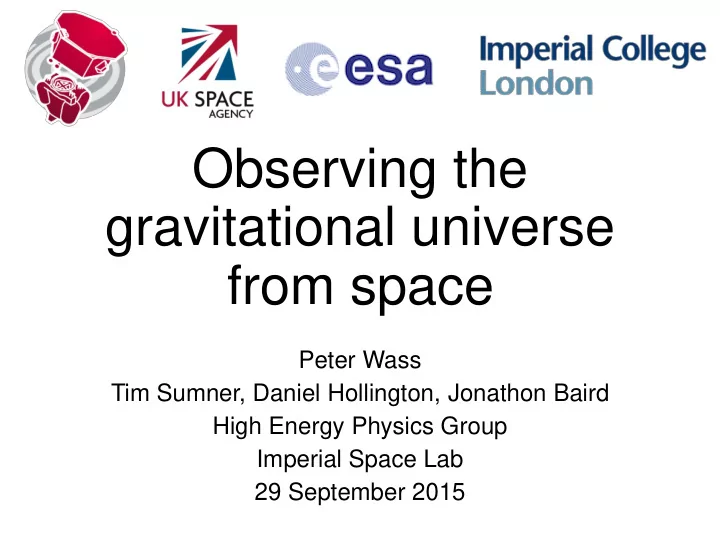

Observing the gravitational universe from space Peter Wass Tim Sumner, Daniel Hollington, Jonathon Baird High Energy Physics Group Imperial Space Lab 29 September 2015
Gravitational Waves • Gravitational waves are ‘ripples’ made by moving objects • A very weak effect, stretches space by a part in 10 21 or less. • Only the most dramatic events in the universe are observable • Detectable as a stretching and compressing of distance between two objects in free-fall Image: ESA – C.Carreau
Gravitational Waves
LISA • A candidate for the 3 rd ESA Cosmic Vision L-class mission to explore the chosen science theme of the gravitational universe • Constellation of three spacecraft acting as end-stations of a laser interferometer 5-million km (16 light-seconds) apart • Test masses inside the spacecraft are in pure free-fall • Lasers track motion of test-masses and spacecraft to pico-meter precision
LISA • A gravitational wave antenna scanning the sky over the course of a 1-year orbit • Will detect thousands of sources simultaneously that need to be carefully extracted from the noise Image: Gravitational Universe Image: NGO-YB
LISA In our galaxy LISA will observe thousands Many systems that we know ‘should’ be of compact binary systems emitting GWs Something completely new? Observations of merging super-massive black Small black holes being ‘swallowed’ test holes (SMBH) reveal information about galaxy Relativity in strong field regime at the formation back to the beginning of the universe very edge of a SMBH
LISA Pathfinder • LISA is a completely new kind of space mission • ESA decided on a dedicated proof-of-concept mission to reduce risk • First proposed in 1998 now ready for launch in November Image: ESA/ATG medialab
LISA Pathfinder UK Contributions Airbus Defence and Space Spacecraft prime contractor ABSL Battery Scisys On-board SW Imperial College London Charge management University of Glasgow Optical bench University of Birmingham Phasemeter MSSL Photodiodes Image: ESA/ATG medialab
LISA Pathfinder • Two test masses separated by 38cm inside one spacecraft - no gravitational wave detection • Capacitive inertial sensors detect test mass position • Micro-Newton thrusters allow the spacecraft to follow the test mass motion Image: ESA/ATG medialab
LISA Pathfinder • Laser interferometer measures relative motion of masses to 10pm precision • Measure forces that could limit GW detection: below 60fN/√Hz in the measurement band Image: ESA/ATG medialab
Test mass charging Free-falling test masses will accumulate charge resulting in electrostatic forces Identified the space environment as source of disturbances for this type of mission Developed models of the space environment and how it interacts with the spacecraft structure to cause charging Image: NASA/STEREO
Test mass charging • Neutralise the test mass with non-contact method • Illuminate gold surfaces with ultra violet light • Transfer charge to or from the test mass by photoemission Image: ESA/ATG medialab
Hardware Designed and built a system of UV lamps and controlling electronics to generate light which will precisely control the charge on the test mass Installed on spacecraft at Airbus Stevenage
Operations • Demonstrate that the technology is capable of measuring gravitational waves • Measure all effects that are limiting the performance • space craft magnetic field • stray electrostatic fields in the sensor • test mass charging from space environment • self-gravity of spacecraft • residual gas around the sensor • radiation pressure fluctuations from the laser • temperature gradients across the sensor • s tability of applied voltages…
New Technology • LISA technology must be even more sensitive and stable than LISA Pathfinder • Imperial leading the development of a new discharge system for LISA • Based on new deep-UV LED technology • Simpler to operate, more versatile, and efficient than lamps • Physics of discharging
Headlines • LISA Pathfinder will launch in November this year with Imperial Technology on-board and Imperial scientists leading data-analysis. • LISA is an opportunity to observe the universe in a totally new way. • Imperial and the UK are well placed to play a major role in LISA.
27 November 2015 • sd
Recommend
More recommend